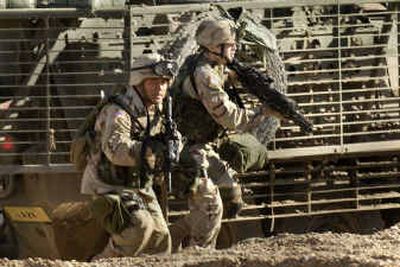More troops for Iraq

WASHINGTON – The Pentagon said Wednesday that it will boost the number of U.S. troops in Iraq to about 150,000, the highest level since the U.S. occupation began 19 months ago.
Most of the increase in the troop count, which stands at about 138,000 now, will come from extending deployments of units already there as others arrive. That will keep some soldiers in Iraq for combat tours of 14 months, beyond the yearlong mission that most troops are told to expect, Pentagon officials said. In addition to extending some brigades from the 1st Cavalry Division, the 25th Infantry Division and the 31st Marine Expeditionary Unit, about 1,500 paratroopers from the 82nd Airborne division will be sent from Fort Bragg, N.C., to Baghdad for about 120 days.
The increase in troop strength, which had been hinted at by senior U.S. military officials for weeks, is primarily driven by the need to tamp down the Iraqi insurgency as elections set for the end of January draw near. “The purpose is mainly to provide security for the elections, but it’s also to keep up the pressure on the insurgency,” Army Brig. Gen. David Rodriguez, deputy director of regional operations for the Joint Chiefs of Staff, said at a Pentagon briefing.
Other military experts, however, said the escalation reflects the more intense nature of the war after the U.S.-led assault on the rebellious Sunni town of Fallujah, west of Baghdad.
“The ferocity with which the war is being waged by both sides is escalating,” said Jeffrey White, a former Defense Intelligence Agency analyst who is now at the Washington Institute for Near East Policy. “It is not just that the number of incidents are increasing. The war looks to be changing in character.”
Retired Army Col. Ralph Hallenbeck, who worked in Iraq with the U.S. occupation authority last year, said he worried that the move represents a setback of the basic U.S. strategy of placing a greater burden on Iraqi security forces to control the country and deal with the insurgency. “I fear that it signals a re-Americanization … of our strategy in Iraq,” he said.
Defying expectations
Indeed, adding troops at this point is the opposite of what senior Pentagon officials expected when the war began in March 2003. Before the invasion, Deputy Defense Secretary Paul Wolfowitz dismissed an estimate by Army chief of staff Gen. Eric Shinseki that several hundred thousand troops would be needed to occupy Iraq after Saddam Hussein’s regime fell. “I am reasonably certain that they will greet us as liberators,” Wolfowitz told a congressional committee, “and that will help us to keep requirements down.”
The original war plan, which was based on that assumption, called for a series of quick reductions in troop levels in 2003, to perhaps 50,000 by the end of that year. A revision of that plan, devised 12 months ago, called for steady reductions this year.
Instead, occupation forces hit their lowest level last winter, bottoming out near 110,000 in February. Then in late March the insurgency intensified and broadened, with heavy fighting in Shiite areas of south-central Iraq for the first time. Since then, U.S. troop numbers have risen in response to the unexpected strength and growing sophistication of the enemy.
“Plan A – what the U.S. actually did – failed, and Plan B – the adaptations since the end of ‘major combat’ – hasn’t worked either, so far,” said retired Army Col. Raoul Alcala, who has served as an adviser to the Iraqi Ministry of Defense, referring to President Bush’s May 1, 2003, announcement that major combat operations had ended in Iraq.
Some observers said the latest announcement indicates that the Pentagon is recognizing just how long the effort in Iraq may take. “This announcement makes it clear that commanders in Iraq need more troops and that this will be a long and very expensive process for the United States,” said Sen. Jack Reed, D-R.I., a member of the Senate Armed Services Committee who recently returned from a visit to Iraq. Reed, who served in the Army with the 82nd Airborne, also said in an interview it is becoming increasingly clear that Iraqi forces won’t be capable of taking over from U.S. forces for five to 10 years.
Wednesday’s extensions mark the third time that the military has ordered troops to serve in Iraq longer than they expected. Such extensions at first provoked anguish among family members who have been counting the days until the return of their deployed soldiers. When the 3rd Infantry Division had its tour extended in the summer of 2003, it prompted widespread grumbling, with some soldiers criticizing Defense Secretary Donald Rumsfeld by name. But as the extensions have become more common in Iraq, the troops, their wives and children have become more accustomed to them.